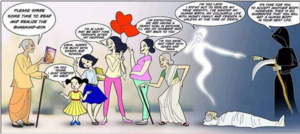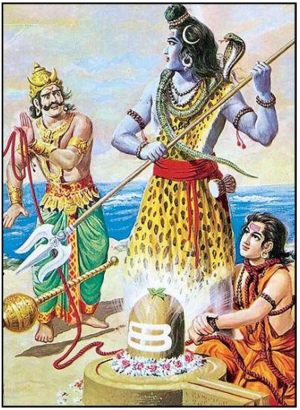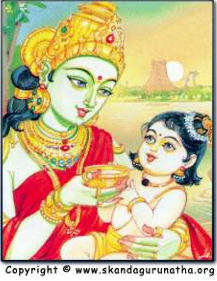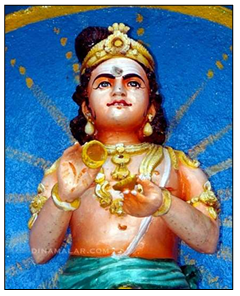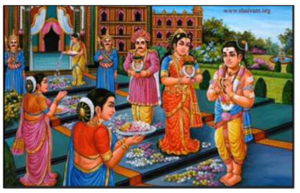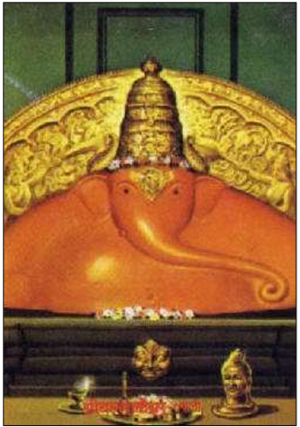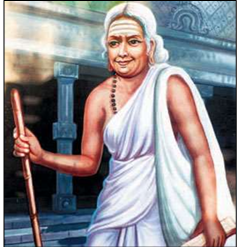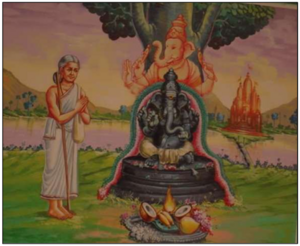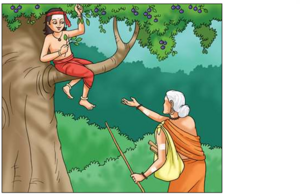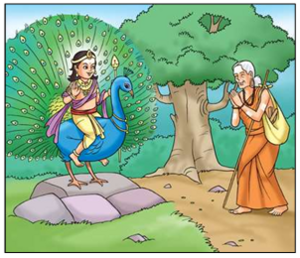Talk:Age
By Vishal Agarwal
One does not have to be an adult or an elderly person to practice Bhakti. The doctrine of rebirth in Hindu Dharm permits the possibility that due to the impact of good Karma and practice of Bhakti in previous lives, even a child can distinguish himself as a devotee of the Bhagavān. In fact, in all the major traditions of Hindu worship, the Bhagavān is depicted as a child too, and this is manifest as the Vātsalya Bhakti that is described later. Child devotees like Prahlāda and Dhruva in the Vaiṣṇava tradition, Markaṇḍeya in the Śaiva tradition, Ballāla in the Gāṇapatya tradition, etc. are well known. These stories exalt innocent devotion to God above everything else and make liberation accessible to even children and teenagers.
Several prayers and hymns[1] occurring in Hindu texts are ascribed to children. In more historical times, numerous children and teenagers became saints through the path of Bhakti. Even today, it is not uncommon to come across spiritually gifted children leading congregational chanting of hymns, and the author has personally participated in one such event. Therefore, Hindu scriptures exhort that children should be directed towards Bhakti from a very young age. It is neither too early, nor too late to love the Divine, because the correct time is now.
Wise people should cultivate the devotional mode of life from childhood itself. This is because human birth, in which alone God-realization – the supreme end of man’s existence – can be had, is rare and difficult to get; and besides, life is short and precarious. Bhāgavata Purāṇa 7.6.1
Svāmī Chinmayananda and many other Hindu saints have emphasized the need to involve children in different religious ceremonies and celebrations right from a tender age so that they develop an interest in these early on. Their advice is based on Hindu scriptures. Ṛgveda 8.69.8 urges that parents along with their children should pray to the deity Indra, who is a refuge like a mighty fortress.
O People! Worship Indra with melodious songs; sing, O Priyamedhas, with worshipful reverence. Let children also join in idolizing Indra, who is mighty and strong like an impregnable fortress. Ṛgveda 8.69.8
The scriptural injunction to include children in family and congregational prayers is maintained in later Hindu texts[2] as well as in modern Hindu practice.[3]
Story – Ṛṣi Markaṇḍeya Becomes Immortal with the Blessing of Śiva
Long, long ago, there lived a sage named Mṛkaṇḍu and his wife Marudvatī. They had no children and so, they prayed to Śiva to grant them a child. Bhagavān Śiva was pleased with their devotion. He appeared to the couple and asked them to choose between a son who would be very Dhārmika and devoted to Śiva but would live for just 16 years; or a hundred sons who would be foolish but live long lives. Since Sage Mṛkaṇḍu and Marudvatī were a very virtuous couple, they asked for the first son who would be wise and devoted to Bhagavān, even if he were to live only 16 years.
Soon thereafter, a son was born to the couple, and they named him Markaṇḍeya. Just as Bhagavān Śiva had promised, Markaṇḍeya grew up to be a very wise and Dhārmika boy. However, as he got closer to sixteen years of age, he started noticing that his parents became sadder and sadder. He asked them the cause of their sadness. When he learned that he would die soon, he said – “Do not worry. I will worship Bhagavān Śiva to extend my life, because He answers the prayers of His true devotees.”
As he approached his sixteenth birthday, Markaṇḍeya began worshipping Śiva in the form of a Śivaliṅga. On his 16th birthday, Yamarāja, the Devatā of death, appeared and started to pull Markaṇḍeya’s soul out of his body. But Markaṇḍeya did not get scared and continued his worship. He grabbed the Śivaliṅga tightly.
Bhagavān Śiva emerged from the Śivaliṅga, and when He saw that Yamarāja was ending the life of His devotee, He became furious. He appeared in front of them and scared Yamarāja away. He scolded Yamarāja and asked him never to harm His devotees.
Then, He blessed Markaṇḍeya with eternal life and told him that he would never die. Markaṇḍeya grew to become a great Ṛṣi, and one of the eighteen major Purāṇas is named after him – the Markaṇḍeya Purāṇa. People believe that Markaṇḍeya still lives on, invisible to us.
Draviḍa Śiśu – Tirujñāna Saṃbandhar (643–659 CE)
One of the greatest saints of Śiva-bhakti, Saṃbandhar was born in the 7th century in Śirkāḷi, Tamil Nadu to a pious Brāhmaṇa Śivapāda Hṛdayar and his virtuous wife Bhagavatīyar. One day, Śivapāda Hṛdayar and his wife took the child with them to the temple tank in which they wanted to bathe. The child looked at the tower of the temple and began to cry.
Devī Pārvatī appeared and fed the Milk of Divine Wisdom to Saṃbandhar. From the moment he drank the Milk of Wisdom (at the age of 3), he began to sing soul-stirring songs in praise of Bhagavān Śiva. The next day, Saṃbandhar went to a place called Thirukkolakkā. He sang a hymn in praise of the “Meaning of Vedas,” clapping his hands to keep time. Bhagavān Śiva, pleased with this, presented him with a pair of golden cymbals (jāḷrā). Saṃbandhar began to sing, with the help of the golden cymbals.
Saṃbandhar then went on pilgrimages. Wherever he went, crowds of people followed him, joining him in singing bhajans. As he was just a little boy of eight years of age, enthusiastic bhaktas often carried him on their shoulders. His feet often grew tired walking from temple to temple while singing bhajans. Bhagavān Śiva came in a dream to the priests of a Maṇḍira and asked that Saṃbandhar be carried in a palanquin while singing to the crowds of bhaktas.
Once, he came to the home of a great Śiva-bhakta known as Śivaneśa Cheṭṭiyār in the town of Māyilāpūr, close to the modern Indian city of Chennai. He learned that Śivaneśa’s only daughter had died, but Śivaneśa had loved his daughter so much that he had preserved her bones after cremation in a pot in his home. Saṃbandhar asked for that pot and prayed to Śiva to bring the girl back to life. A miracle happened, and as everyone watched in amazement, the daughter of Śivaneśa arose from the bones and became a living human being.
After visiting several shrines and singing hymns in praise of the Bhagavān, Saṃbandhar returned to Śirkāḷi at the age of sixteen. There, many people urged him to get married because the Vedas commanded every human being to marry. Saṃbandhar agreed and was married to a beautiful girl. The marriage was conducted with great pomp. But soon after the marriage, Saṃbandhar and his bride went to a Śiva Maṇḍira in her hometown. As Saṃbandhar sang a bhajan to the Śivaliṅga, a beam of light emerged from the mūrti and the couple merged into that light and disappeared. Bhagavān Śiva had taken Saṃbandhar and his wife to His abode and had granted them mokṣa.
He is one of the most prominent of the sixty-three Nāyaṉmārs—Tamil Śaiva Bhakti saints. He wrote 384 songs in praise of Śiva in the Tamil language. He contributed not only to the development of Śiva-bhakti but also to the development of devotional music.
Gaṇeśa Loves Children: Ballāleśvara Maṇḍira of Pālī
There are eight main temples of Gaṇeśa, all of which are located in the state of Maharashtra in India. One of these temples is called the Ballāleśvara Temple, located in the village of Pālī. There is a very beautiful story behind this Maṇḍira, showing how much Gaṇeśa loves children who love Him.
In the village of Pallīlpura, there lived a merchant named Kalyāṇa with his wife Indumatī. They had a son Ballāla, who was very devoted to Gaṇeśa from his childhood. All the other kids in his neighborhood were greatly impressed with Ballāla’s love for Gaṇeśa. Therefore, they too started worshipping Gaṇeśa with Ballāla very regularly. They would collect small stones. They imagined these stones to be little mūrtis of Gaṇeśa. And then, they would all do a pūjā to these stones.
The parents of the children got very upset. They thought the kids were wasting time doing pūjā when they should be studying or playing. They blamed Ballāla. They went to Kalyāṇa and complained, “Your son is fooling our children. What do these kids know about how pūjā should be done? They should wait to grow up first and earn money. Then they can do pūjā if they want to.” Kalyāṇa scolded Ballāla, but Ballāla replied, “I do not force anyone. They come because we all love Gaṇeśa.”
One day, Ballāla and his friends all went to the forest to play. There, Ballāla found a large rock that looked like Gaṇeśa. They constructed a small hut over the rock and started doing a pūjā. They sang songs and offered flowers. Several hours went by. The parents got worried and complained to Kalyāṇa.
Kalyāṇa went looking for the kids and found them doing pūjā. He yelled and the children ran home. But Ballāla remained lost in worship. Kalyāṇa was furious. He beat his son with a stick, tied him to a tree, and broke the rock idol, saying, “Let me see how your Gaṇeśa helps you!”
Ballāla prayed to Gaṇeśa to help him. Bhagavān Gaṇeśa appeared immediately and freed him. He punished Kalyāṇa and said, “You have harmed My devotee. For this, you will suffer in this life and the next.” Then He said to Ballāla, “My child, I liked how you and your friends worshipped Me. I will henceforth live here so that you can do pūjā to Me anytime you want. I will now be called ‘Ballāleśvara’ – the Īśvara worshipped by Ballāla. Also, I command that people shall first worship the rock you found, and then Me.”
Gaṇeśa then turned into a large stone mūrti. Today, that place is home to the Ballāleśvara Temple at Pālī, one of the eight revered Āṣṭavināyaka temples of Bhagavān Gaṇeśa. When we visit that temple, we first worship the stone found by Ballāla, and then the mūrti of Ballāleśvara.
Avvaiyār, the Wise Granny
One day, Devī Sarasvatī decided to live on the earth as a human being to experience how life was in our world. She was born as a beautiful daughter named Avvaiyār to a very religious couple. From her childhood, she was deeply devoted to Bhagavān Gaṇeśa. As she grew older, her parents wanted her to get married. But Avvaiyār wanted to spend her life worshipping Śiva, Gaṇeśa, and Kārttikeya. She prayed to Gaṇeśa, “Bhagavān, please change my appearance from that of a beautiful girl to an old woman. Then no one would want to marry me.” Bhagavān Gaṇeśa granted her wish, and she became an old woman.
Avvaiyār now spent all her time worshipping Gaṇeśa and spreading the message of Hindu Dharm among the people of her country. People loved her and her teachings. Children would ask her to sing a song for them when they saw her. Her name ‘Avvaiyār’ means ‘Granny’, which shows that everyone respected and loved her a lot.
Pleased with Avvaiyār’s bhakti, Bhagavān Gaṇeśa appeared to her and said, “What boon can I give to you, lady?” Avvaiyār said, “Bhagavān, I will give you four things. But in return, I request only three gifts. Does that sound like a good deal to you?” Gaṇeśa was pleased. He said, “Who can refuse your offer? But tell me first, what will you give Me?”
Avvaiyār said, “I will give you milk, jaggery, pure honey, and lentils.” Gaṇeśa thought, “I love to eat, and we can make a lot of dishes out of these four items.” So He asked her, “I love your four gifts. Now tell Me, what three things shall I give you in return?” Avvaiyār replied, “I want you to give me the ability to write good poetry in Tamil, good prose in Tamil, and also good drama in Tamil.” Gaṇeśa was impressed with Avvaiyār’s intelligence and gave her all three gifts.
Avvaiyār now became a famous writer of poems, prose, and dramas. Many of her sayings still survive today. But as people began to praise her, she became a little proud of her fame. Bhagavān then thought of teaching her a lesson.
One day, she was passing through a forest and felt hungry. She saw a tree laden with delicious fruit and a boy sitting on a branch. She called out to the boy, “Can you pluck some fruit and throw them down to me? I am hungry.” The boy said, “Do you want the fruit cold or hot?” Avvaiyār laughed, “How can fruit growing on a tree be cold or hot?” The boy again asked, “I will throw fruit to you only if you tell me whether you want them hot or cold.”
Avvaiyār, very hungry, said half-heartedly, “I want them cold.” The boy immediately plucked a fruit and threw it on the ground. It got soiled with dust. When Avvaiyār picked it up, she began blowing on it to clean it. The boy laughed, “If you wanted cold fruit, why are you cooling it with your breath?” Avvaiyār realized this boy was no ordinary person. She prayed respectfully, “Tell me Sir, who are you?” And then, the boy revealed His true form as Kārttikeya.
Avvaiyār thanked Him for making her realize that she had become too proud of her wisdom. When Avvaiyār became old, she travelled to Mount Kailāsa with the help of Bhagavān Gaṇeśa to have a darśana of Bhagavān Śiva.
Sant Jñāneśvara
Jñāneśvarī, the oldest surviving commentary on the Bhagavadgītā in an Indian vernacular and also one of the most influential, was completed by its author Sant Jñāneśvara in the year 1290, when he was merely nineteen years old. He and his siblings showed saintly qualities even as children, and are today revered by millions of members of the Vārkarī sect of Hindus. Numerous blockbuster movies have been made on his life, and he is conventionally portrayed as a teenager with an angelic smile.
Guñjamālī and the Child Playmates of Kṛṣṇa
Guñjamālī, originally from Lahore, was a disciple of Caitanya Mahāprabhu. When his son died, he ascertained that his daughter-in-law was a sincere and humble Vaiṣṇava and decided to retire to the Vraja region. There, he spent his time in the service of Śrī Gopāla, the presiding Devatā of a temple.
Near the temple lived a group of boys who loved playing with sand and throwing it on one another. One day, Guñjamālī noticed that the mūrti of the Bhagavān was smeared with sand. He got very angry and drove the boys away. Afterwards, he offered food to the Bhagavān as usual, but the food remained untouched – a sign that it had not been accepted.
Guñjamālī became sad and asked the Bhagavān if he had done anything to offend Him. The Bhagavān replied, “I will accept your food only when you bring the children back and allow them to play in My presence.” Guñjamālī pleaded, “If You want, I can smear Your image completely with sand. But please eat now. Tomorrow morning, I will personally go and invite the boys.” But the Bhagavān would not accept the offering.
So Guñjamālī went to the neighborhood and said to the boys, “I apologize for my anger. The Lord Himself invites you to play in His presence. If you return and play as before, I will give you laddūs.” The children obliged.
Seeing the children playing again, the Bhagavān was pleased and finally accepted the food offering of Guñjamālī.[4]
References[edit]
- ↑ An example of such a prayer supposedly composed by children is the Bālakṛta Kṛṣṇastotra occurring in the Brahmavaivarta Purāṇa.
- ↑ For instance, Matsya Purāṇa 1.18.1–5 states that if a man visits the temple of Viṣṇu and listens to religious discourses in the company of his wife and children, he abides in heaven for a long time.
- ↑ Huyler 1999 gives numerous photographs of Hindu children engaged in worship, rituals, and religious festivities.
- ↑ Nābhādāsa (Nābhā Gosvāmī). Śrī Bhaktamālā with Commentary by Śrī Priyadāsa. Translated by Bhūmipati Dāsa, edited by Pūrṇaprajña Dāsa, Rasbihari Lal and Sons, 2017, Vṛndāvana, India. Commentary on text 103 of Bhaktamālā by Priyadāsa.

